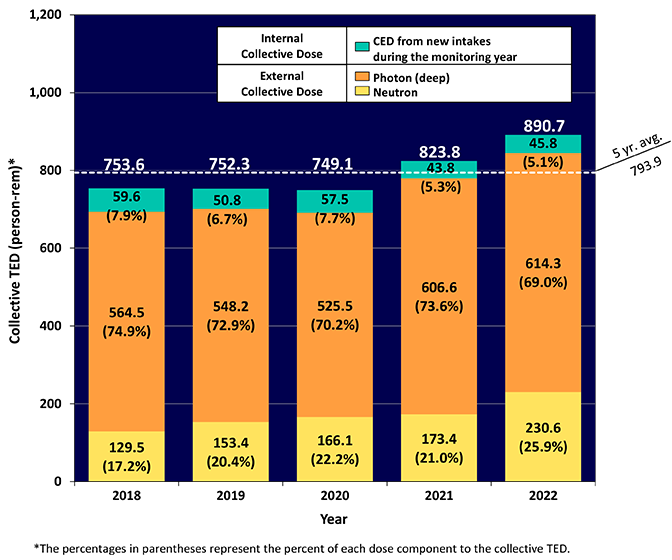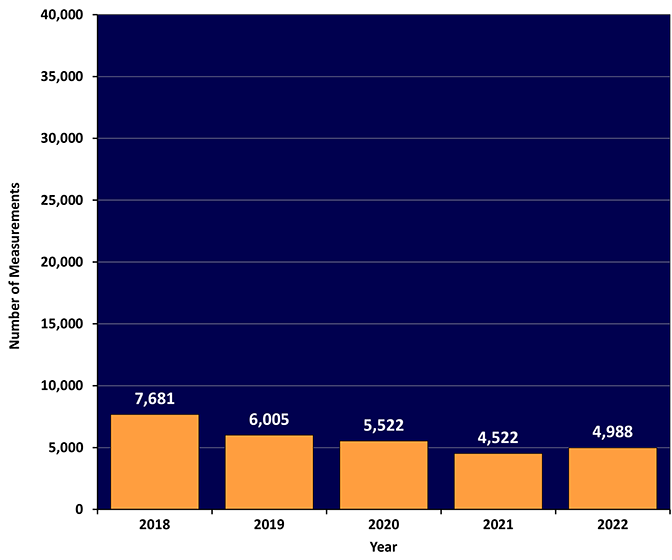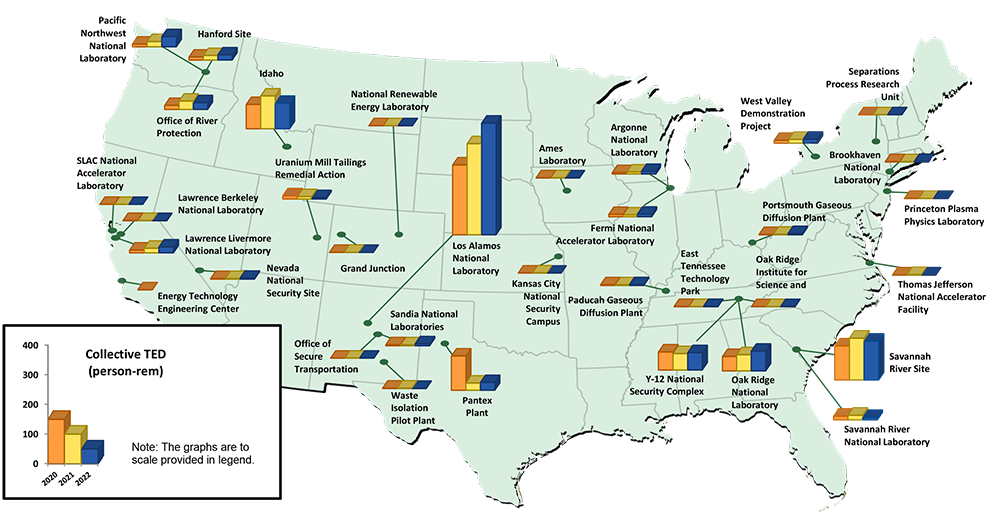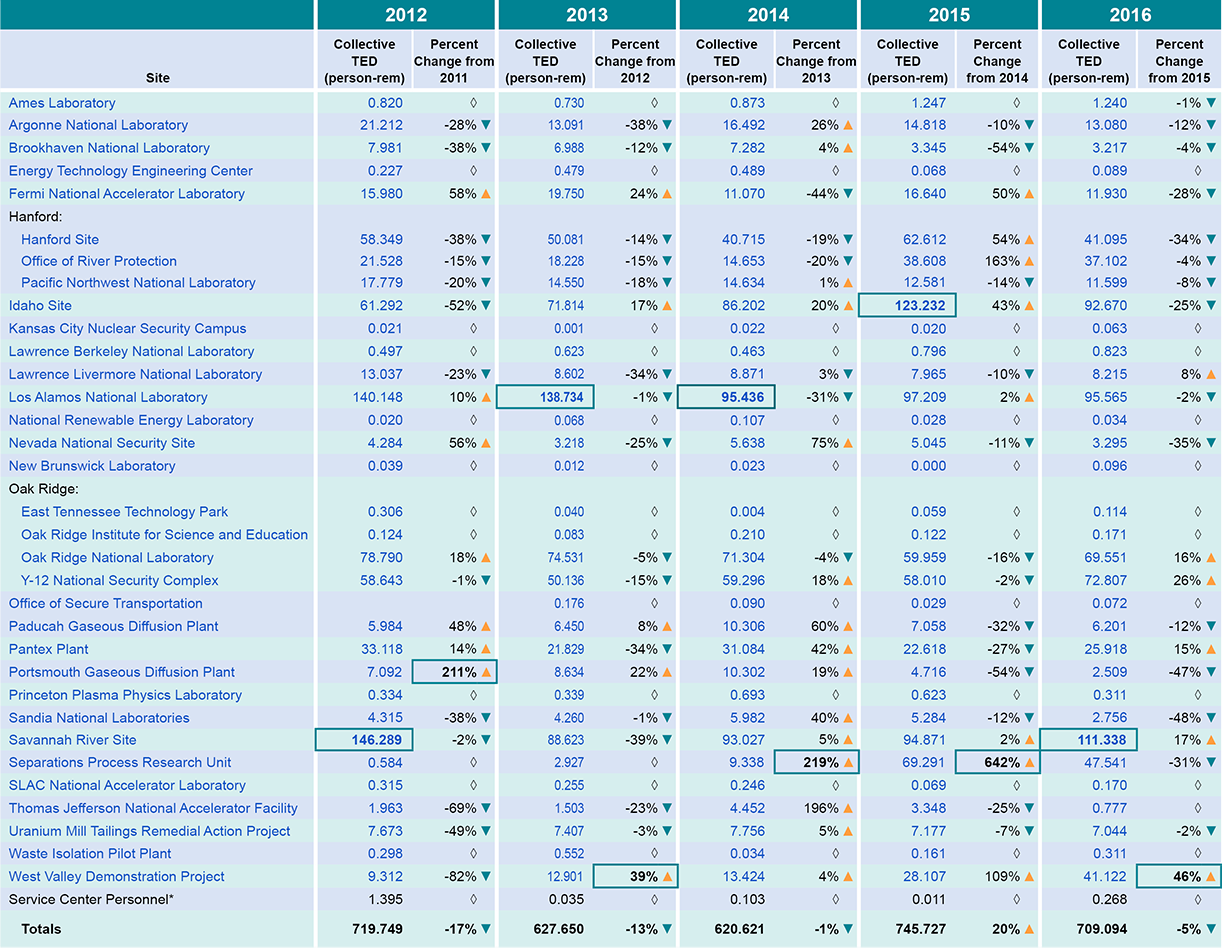U.S. Department of Energy
2023 Occupational Radiation Exposure Dashboard
Radiation Exposure Monitoring System
Query Tool
The REMS Query Tool is intended to provide quick and easy access to summary information on radiation exposure at DOE facilities. A query tool such as this is often referred to as a "Data Mart". A simple 4-step process allows the user to view and extract the most commonly requested information on occupational exposure from 1986 to the present.
- Select the data items of interest
- Select the data filters, such as a range of years, a specific site, or a reporting organization
- Group the data to sum it in the order of your preference
- View the results in a table format, or download as an Excel file
The REMS Query Tool is updated each year as annual data is collected from the sites or when the sites submit updated records. It is therefore the best place to access the most up-to-date occupational exposure data.
During 2023
Increases in the dose and number of individuals with measurable dose were the result of increased activities involving radioactive materials, particularly at the DOE sites that comprise the majority of DOE collective dose.
- DOE facilities continued to comply with DOE dose limits and ACL and worked to minimize exposure to individuals.
- Although the number of monitored individuals continued to increase post-COVID, the percentage of individuals with measurable dose remained the same at 22 percent from CY 2022 to CY 2023.
- The collective TED for transients decreased slightly from 30.81 person-rem (308.1 mSv) in CY 2022 to 29.61 person-rem (296.1 person-mSv) in CY 2023.
- The number of individuals with measurable dose increased 10 percent from a value of 16,774 in CY 2022 to a value of 18,469 in CY 2023.
- The collective TED increased at DOE by 6 percent from 893.1 person‑rem (8,931 person‑mSv) in CY 2022 to 949.4 person-rem (9,494 person-mSv) in CY 2023.
- The collective CED (predominately internal exposure to U-234) decreased by 9 percent from 45.8 person-rem (458 person-mSv) in CY 2022 to 41.6 person-rem (416 person-mSv) in CY 2023.
Over the past 5 years
In CY 2019, the collective TED for DOE decreased by less than 1 percent or 0.6 person rem (60 person-mSv). In CY 2020, the collective TED for DOE decreased by less than 1 percent or 4 person-rem (40 person-mSv). Additionally, the majority (62 percent) of DOE facilities cited the COVID-19 pandemic as limiting operational activities in CY 2020. In CY 2021, the number of facilities citing the COVID-19 pandemic as limiting operational activities decreased from 62 percent to 53 percent. With the increase in the number of monitored individuals post-COVID, the percentage of individuals with measurable dose decreased to 22 percent in CY 2022 from 25 percent in CY 2021. In CY 2023, the collective TED increased by 6 percent from CY 2022, as 17 of the 33 sites reported increases in collective TED.
- For 3 of the past 5 years, the collective dose was above the 5-year average of 776.1 rem.
- For CY 2023, 53 percent of the DOE workforce was monitored for radiation dose, and 22 percent of monitored individuals received a measurable dose.
- The number of individuals with measurable dose increased 33 percent (increased by 4,637 individuals) over the past 5 years.
- The collective TED increased by 26 percent (increased by 56.4 person-rem) from CY 2019 to CY 2023.
Historical perspective
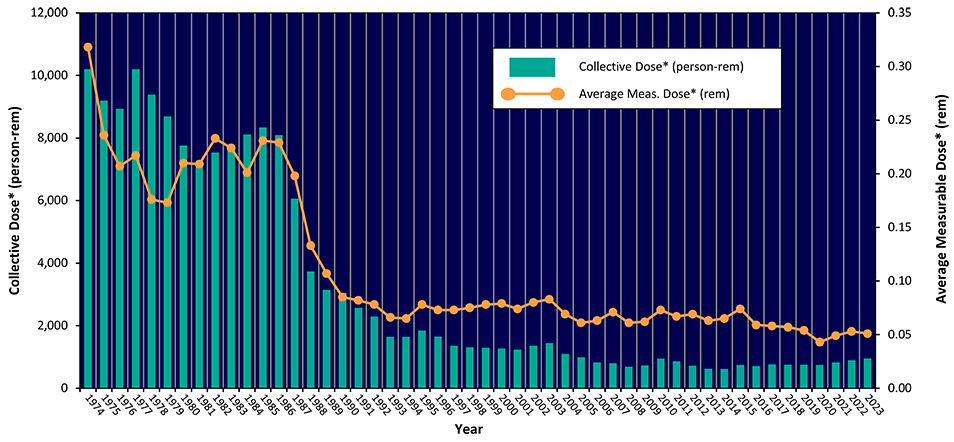

1974
Policy
- The Federal Administration Act of 1974 is signed, replacing the Federal Energy Office with the Federal Agency Administration.
- Energy Research and Development Agency (ERDA) and Nuclear Regulatory Commission (NRC) created by Energy Reorganization Act of 1974.
1975
Sites
- ERDA replaces AEC to manage the Hanford site. Expansion of the gaseous diffusion plant capability at Oak Ridge Operations Office.
- Major reactor plant modification for installation of the Light Water Breeder Reactor (LWBR) core at the Shippingport Atomic Power Station.
Geopolitical
- Atomic Energy Commission (AEC) Formally Split into Energy Research and Development Agency (ERDA) and NRC.
- NRC Assumes AEC functions.
1976
Geopolitical
- China conducts an atmospheric test (impacting the United States with environmental contamination issues).
1977
Sites
- DOE assumes control of the Hanford site from ERDA.
Policy
- The Department of Energy Organization Act is signed, abolishing the Federal Energy Administration and ERDA.
- ERDA becomes the Department of Energy.
- James R. Schlesinger sworn in as first Secretary of Energy.
Geopolitical
- Publication of International Commission on Radiological Protection (ICRP) Report No. 26, Recommendations of the ICRP.
1979
Sites
- Three DOE contractor employees at three separate facilities received whole-body dose equivalents greater than 5 rems during 1979.
Geopolitical
- Three Mile Island {TMI) Reactor Accident.
- Publication of ICRP Report 30, Limits for Intakes of Radionuclides by Workers.
1981
Policy
- Reagan Administration announces a nuclear energy policy that anticipates the establishment of a facility for the storage of high-level radioactive waste and lifts the ban on commercial reprocessing of nuclear fuel.
1982
Policy
- Congress passes the Nuclear Waste Policy Act (NWPA).
1984
Geopolitical
- Radon gas problem identified in Pennsylvania (Reading Prong).
1986
Sites
- Gaseous Diffusion Plant Shut Down (K-25).
- Construction of Saltstone at SRS begins.
Policy
- DOE Laboratory Accreditation Program (DOELAP) begins.
- DOE Policy Change from Statistical Summary Reporting to Individual Dose Records for Each Worker — 1986-1987.
- DOE Order 5480.11, Radiation Protection for Occupational Workers, in effect — 1985-1989.
- Internal radionuclide intakes are converted to internal doses and results reported using Annual Effective Dose Equivalent (AEDE) methodology — 1985-1989.
Geopolitical
- Chernobyl Nuclear Reactor Meltdown Occurred.
1987
Sites
- N-Reactor Shut Down (RL).
- C-Reactor Shut Down (SRS).
- PUREX & UO3 Plants Shut Down (RL).
Policy
- DOE Policy Change from Statistical Summary Reporting to Individual Dose Records for Each Worker — 1986-1987.
- Issue of EPA Federal Guidance Policy Recommendations, Radiation Protection Guidance to Federal Agencies for Occupational Exposure.
- Publication of National Council on Radiation Protection & Measurements 91, Recommendations on Limits for Exposure to Ionizing Radiation.
- DOE Order 5480.11, Radiation Protection for Occupational Workers, in effect — 1985-1989.
- Internal radionuclide intakes are converted to internal doses and results reported using Annual Effective Dose Equivalent (AEDE) methodology — 1985-1989.
Geopolitical
- Intermediate-Range Nuclear Forces Treaty - December
1988
Sites
- K-, L-, & P-Reactors Shut Down (SRS).
- Bulk Shielding Reactor Shut Down (ORNL).
Policy
- DOE promulgates DOE Order 5480.11, Radiation Protection for Occupational Workers.
- EPA publishes Federal Guidance Report No. 11 (Environmental Protection Agency 520/1-88-020), Limiting Values of Radionuclide Intake and Air Concentration and Dose Conversion Factors for Inhalation, Submersion, and Ingestion.
- DOE Order 5480.11, Radiation Protection for Occupational Workers, in effect — 1985-1989.
- Internal radionuclide intakes are converted to internal doses and results reported using Annual Effective Dose Equivalent {AEDE) methodology — 1985-1989.
Geopolitical
- DOE reports no DOE reactor is producing Tritium for nuclear weapons.
1989
Sites
- Plutonium Fabrication Plant (PFP) Shut Down (RFETS).
Policy
- DOE Implements both 1987 Federal Guidance and NCRP 91 in Order 5480.11.
- November — Office of Environmental Restoration and Waste Management Established.
- DOE Order 5480.11, Radiation Protection for Occupational Workers, in effect — 1985-1989.
- Internal radionuclide intakes are converted to internal doses and results reported using Annual Effective Dose Equivalent (AEDE) methodology — 1985-1989.
1990
Sites
- High Pressure Tritium Facility Shut Down (LANL).
Geopolitical
- Publication of ICRP 60, 1990 Recommendations of the International Commission on Radiological Protection.
1991
Sites
- Saltstone Waste Processing Begins (SRS).
Geopolitical
- Strategic Arms Reduction Treaty Signed.
1992
Sites
- Idaho Chem. Processing Plant (ICPP) Work Scope Reduced (INEL).
- Tower Shielding Reactor Shut Down (ORNL).
Policy
- DOE RadCon Manual (DOE/EH-0256T) introduced.
- Implementation of RadCon Manual — 1992-1993.
Geopolitical
- DOE Secretary of Energy Testifies that the U.S. is Not Building Any Nuclear Weapons.
1993
Policy
- Implementation of RadCon Manual — 1992-1993.
- Publication of NCRP Report 116, Limitation of Exposure to Ionizing Radiation.
- EPA publishes Federal Guidance Report No. 12 (EPA 402-R-93-001), External Exposure to Radionuclides in Air, Water, and Soil.
Geopolitical
- Congress terminates the Superconducting Super Collider (SSC) project.
1994
Policy
- 10 CFR Part 835, Occupational Radiation Protection, becomes effective.
1995
Sites
- Increased dose due to increased work in the production of power sources for NASA at LANL.
- Dose increased due to increased days of operation and intensity of AGS accelerator; and maintenance surveys conducted on aging equipment at BNL.
- Two key ICPP facilities were deactivated at Idaho.
- Increased dose due to increased activities involved with decontamination and decommissioning; and the processing of potentially unstable residues for safe storage at Rocky Flats.
- Increased dose due to elimination of spent nuclear fuel storage at K Basins and operation of the mixed low-level waste evaporator associated with tank farms at Hanford.
- Defense Waste Processing Facility was restarted near the end of 1995 at Savannah River.
Policy
- International Atomic Energy Agency publishes "International Basic Safety Standards for Protection Against Ionizing Radiation and for the Safety of Radiation Sources" (known as BSS Safety Standards, Safety Series 115-1).
1996
Sites
- Vitrification in glass canisters of highly radioactive liquid wastes begins at the West Valley Demonstration Project.
- Collective dose was significantly reduced due to the installation of the perimeter shielding and completion of the "clean and coat" project at Hanford.
- Reduction in exposure due to completion of major radiological work performed at the ICPP and the deactivation of two key facilities at the ICPP at the Idaho Site.
- Doses at TA-55 were reduced due to ALARA activities at LANL.
- Doses increased primarily due to activities in support of the restart of the Y-12 Plant involving enriched uranium operations at Oak Ridge.
- Environmental restoration activities increased at Y-12, ORNL, and K-25 at Oak Ridge.
- Doses increased due to increased activities and decontamination and decommissioning cleanup at Rocky Flats.
- Activities in spent fuel storage areas decreased dramatically with shutdown of reactors at Savannah River.
- There was one individual in 1996 who received a dose in excess of the 5 rems TED limit due to an unanticipated intake of plutonium at the Savannah Site.
- Activities involving plutonium at LANL decreased in 1996, which resulted in decreased neutron dose by 30%.
Policy
- 10 CFR Part 835 Full Compliance required.
- DOE Order 5480.11 cancelled and RadCon Manual becomes "non-mandatory" following issuance of DOE Notice 441.1, Radiological Protection for DOE Activities.
1997
Sites
- One individual received a dose in excess of the 5 rems (50 mSv) TED limit at LANL.
- Decreases in the collective dose were due to reductions in such activities as materials stabilization, maintenance, and the completion of several key projects at Savannah River, Idaho, BNL, and Oak Ridge.
- Increased plutonium recovery activities.cleanup and repackaging at Rocky Flats, LANL, and Savannah River.
- Production of heat sources for deep-space missions, which was completed in 1997 at LANL.
- Groundbreaking ceremony for the National Ignition Facility (NIF) at LLNL.
- Plutonium Uranium Extraction Facility (PUREX) at Hanford deactivated a year ahead of schedule.
1998
Sites
- 1997 to 1998 - increase in uranium operations in Oak Ridge in support of the restart at Y-12.
- Shutdown of several facilities, the completion of several key projects, and ALARA Initiatives at Hanford, Los Alamos, Idaho, and Brookhaven.
- DOE announces it will dispose of defensegenerated transuranic waste at Waste Isolation Pilot Plant.
- Uranium Mill Tailings Remedial Action Project ends with remediation of the 22nd and final site at Maybell, Colorado.
- SRS announced as the site of a plant to disassemble pits from nuclear weapons and convert the recovered metal to an oxide.
- NIF target chamber dedicated at the LLNL.
Policy
- 10 CFR 835 Amendment.
- DOE-STD-1098-2008 (DOE Standard Radiological Control).
1999
Sites
- One individual received a dose in excess of the 5 rems (50 mSv) TEDE limit at SRS.
- WIPP receives 1st waste shipment.
- Aggressive ALARA programs at Savannah River, Los Alamos, and Idaho.
- Decontamination campaign at SRS to reduce source term.
- Improved work practices, and a delay in several projects at Idaho due to an accident in 1998 which resulted in corrective actions that affected the work control system.
- Workers at the Paducah Gaseous Diffusion Plant (PGDP) unknowingly exposed to plutonium contained in uranium sent from Hanford and Savannah River for recycling between 1952 and 1976.
- High Flux Beam Reactor (BNL) will be closed permanently.
- Ground breaking at ORNL for the Spallation Neutron Source (SNS).
Policy
- RadCon Manual reissued as Radiological Control Standard (RCS).
- EPA publishes Federal Guidance Report No. 13 (EPA 402-R-99-001), Cancer Risk Coefficients for Environmental Exposure to Radionuclides: Updates and Supplements.
- Secretary Richardson proposes legislation to compensate current and former workers at uranium enrichment facilities for cancers resulting from exposure to radioactive contaminants.
2000
Sites
- Three intakes of plutonium at LANL that were in excess of the 5 rems (50 mSv) DOE annual limit.
- One individual received exactly 2 rems (20 mSv) at LANL.
- Reduction of source material and lowering of ambient dose rates at Rocky Flats.
- Change in the biokinetic models used to determine internal dose from uranium intakes at the Oak Ridge Y-12 facility.
- Reduction in operational activities during corrective actions following the plutonium intake event at LANL.
- Fast Flux Test facility (Hanford) to be closed permanently.
Policy
- Secretary Richardson expands proposal to compensate more than 3,000 current and former workers with a broad range of work-related illnesses.
2001
Sites
- One exposure in excess of the DOE Administrative Control Level (ACL) of 2 rems at LANL.
- Reduction in radioactive material from repackaging and shipping activities at Rocky Flats and Hanford.
2002
Sites
- One individual received in excess of the 50 rems (500 mSv) annual extremity limit at LANL.
- Increase in the number of hours of radiological work performed at Rocky Flats.
- Increased processing of spent nuclear fuel in K-Basins at Hanford.
- Increased work on pit manufacturing, Pu-238 fuel and heat source work, nuclear material processing, nuclear materials science, pit disassembly, and associated support at LANL.
- Work begins on new high-level waste vitrification plant at Hanford.
- 563rd and final shipment of TRU waste from INEL received atWIPP.
- WVDP successfully completes nation's first radioactive waste vitrification program.
Policy
- 25th anniversary of DOE formation.
- DOE, EPA, and State of Washington agree to accelerate cleanup at Hanford.
- DOE, EPA, and State of South Carolina agree to accelerate cleanup at SRS.
- DOE, EPA, and State of Tennessee agree to accelerate cleanup of Oak Ridge sites.
- DOE informs State of South Carolina that shipments of plutonium to SRS will begin.
2003
Sites
- Two exposures in excess of the DOE 5 rems (50 mSv) annual TED limit at LANL.
- Thermal stabilization and repackaging of plutonium-bearing materials, processing of spent fuels, and accelerated cleanup at Hanford.
- Resumption of processing of radioactive material, special programs, and accelerated facility closure and waste processing activities at Savannah River.
- Work activities associated with the building 9204-4 Cleanup Project at Oak Ridge.
- TVA Off-Specification Fuel repackaging project at Oak Ridge.
- Processing of more materials containing americium, an upgrade to the material storage vault, and the decontamination and decommissioning of the Omega West reactor at LAN L.
- SRS downblends HEU into LEU and makes first shipment to Nuclear Fuel Services (NFS), Erwin, TN.
- Rocky Flats makes final shipment of nuclear weapons-usable material from the site.
Policy
- On August 19, 2003, DOE approved and issued the revised DOE Order 231.1A.
2004
Sites
- One individual received in excess of the DOE ACL limit at Hanford.
- One individual received in excess of the DOE ACL limit at Rocky Flats.
- Rocky Flats radioactive source material was shipped off site for disposal.
- Completion of thermal stabilization and repackaging of plutonium-bearing materials at Hanford.
- Deactivation & decommissioning activities at the Plutonium Finishing Plant at Hanford.
- Decreased number of tank farm entries at Hanford.
- Completion of work, including de-inventory of a number of facilities at Savannah River.
- Suspension of nonessential operations at LANL during the second half of 2004.
- Decrease in the isotope production work that took place at ORNL during 2004.
Policy
- The DOE Manual 231.1-1 A, which details the format and content of reporting radiation exposure records to DOE, was approved on March 19, 2004.
2005
Sites
- Closure of Rocky Flats (cleanup considered complete).
- Completion of several projects ahead of schedule at plutonium facilities at the Savannah River Site.
- Decrease in the amount of work performed for the TVA Off-Specification Fuel Repackaging Project at the Oak Ridge Y-12 NSC.
- Decrease in dose as a result of the completion of plutonium stabilization activities at the Plutonium Finishing Plant at Hanford.
2006
Sites
- Delayed start-up of the Saltstone process at SRS.
- ALARA controls to reduce direct handling of TRU drums at the SRS.
- Reduction in the amount of work performed associated with the TVA off-specification fuel repackaging and other special projects at the Oak Ridge Y-12 NSC.
- Decrease in the isotope production work that took place at ORNL during 2006 due to an outage at the HFIR for the installation of the Cold Neutron Source.
- 41 % reduction in the collective dose at the AMWTP as a result of ALARA initiatives at Idaho.
Policy
- DOE published a proposed amendment to 10 C.F.R. 835 in the Federal Register.
2007
Sites
- One individual received in excess of the DOE 5 rems limit at LANL.
- Planned activities not performed at LANL.
- Significant reduction in work during pause due to safety concerns at LANL.
- Increased awareness due to ALARA initiatives at the Advanced Mixed Waste Treatment Project at INL.
Policy
- 10 CFR 835 Amended.
Geopolitical
- Publication of ICRP 103, 2007 Recommendations of the ICRP
2008
Sites
- One individual received in excess of the DOE ACL limit at LANL.
- Same individual received in excess of the 50 rems COE limit at LANL.
- A safety-driven pause in operations at LANL.
- Reduction in dose rates and work activities at Hanford.
- Reduction in the number of samples processed and source term at Idaho.
2009
Sites
- Accelerated clean-up at Hanford made possible by the ARRA.
- Increased work at Los Alamos Neutron Science Center (LANSCE) TA-55 Plutonium Processing Facility at LANL.
- Maintenance and Decontamination and Decommissioning (D&D) work at TA-53 LANSCE Station.
- Workers performing retrieval, repackaging, and shipping of radioactive solid waste at LANL waste facilities.
- Increased D&D activities at West Valley Demonstration Project.
- Increases in production work assigned by National Nuclear Security Administration (NNSA) at Pantex Plant.
2010
Sites
- One individual received in excess of the DOE 5 rems limit at SRS.
- Increased D&D activities at Plutonium Finishing Plant.
- Increased retrieval and processing TRU waste at Hanford.
- Waste processing including higher dose waste drums and decommissioning at Savannah River Site.
- Isotope processing and cleanup and waste disposal at Oak Ridge.
- Increased decommissioning and decontamination at Idaho.
- Increased manufacturing and related weapons work, processing and shipping solid waste, and maintenance activities at LANL.
Policy
- Effective Implementation Date for the 2007 10 CFR 835 Amendments.
- Under the American Recovery & Reinvestment Act of 2009 (ARRA), funding for cleanup and environmental efforts resulted in a significant increase in collective dose in 2010.
2011
Sites
- Implementation of handheld x-ray devices reduced amount of rework at Savannah River Site.
- Improvements in planning, better configuration in waste storage, and increased worker awareness at Idaho.
- Reduction of ARRA activities at Savannah River and Hanford.
- Programs that encourage workers to track their own dose at Idaho.
Policy
- 10 CFR 835 Revision.
- Incorporated the update of Appendix C, Derived Air Concentration (DAC) for Workers from External Exposure During Immersion in a Cloud of Airborne Radioactive Material.
Geopolitical
- March 11, 2011 — Fukushima Event.
2012
Sites
- Increased worker awareness and planning at the Idaho Site.
- Decrease in the number of targeted waste drums processed at the Idaho Site's Accelerated Retrieval Project.
- Overall reduction of D&D activities and TRU retrieval at Hanford Site.
- Solid Waste Management Facility's use of specialty tools and techniques to reduce exposure time.
Policy
- Decreased ARRA-funded activities.
- UNSCEAR Report - Fukushima 2012. Supplement No. 46 issued.
- WHO report (2012) issued.
2013
Sites
- A significant portion of LANL dose was accrued by workers performing retrieval, repackaging, and shipping of radioactive solid waste at TA-50 and TA-54 waste facilities.
- Reductions at Oak Ridge were achieved through an overall decrease in radworker population throughout the complex and an approximate 2-month decrease in production work in preparation for the government shutdown during the sequestration in October 2013.
- Significant decreases at SRS are attributed to ALARA initiatives that were employed and a host of budget issues that arose during the year.
- The largest contributors to Hanford dose activities were glove box removal at PFP, Tank Farm activities, D&D, waste treatment, storage and handling.
2014
Sites
- Curtailed work with solid waste at LANL due to the contamination release event at WIPP and its relation to LANL waste packaging.
- Increased training exercises for the Homeland Security/Defense Threat Reduction Agency at INL.
- Waste Management group of the ICP started the Sodium Distillation System (SDS) process in the 3rd quarter. This process included cleaning of the slide gate and replacing, installing and removing SOS equipment.
- Implemented the tungsten tote carrier system at SRS to replace the doorstop system for transporting high radiation samples.
- Completed SRNL Cell Window replacements at SRS.
- Completed installation of the Raster beam line at BNL.
2015
Sites
- At Idaho National Laboratory, exposure activities performed included work at the Advanced Test Reactor Complex, including experiment system operations, plant maintenance modifications, routine ATR power operations, routine ATR outage operations, and Research and Development Operations/Laboratory Support.
- At SPRU, increased cleanup activities at SPRU resulted in a 642 percent increase in collective TED from 2014 to 2015.
- In 2015, WVDP dose was attributed to demolition preparation work in the liquid waste cell, all three extraction cells, the off gas cell/off gas blower room, sample storage cell, and the vitrification facility.
- WIPP continued decontamination efforts in the WIPP underground as well as resumption of limited activities.
- At Sandia National Laboratory, there was a decrease in the number of waste and material disposition campaigns at the auxiliary hot cell facility and experiments at the annular core research reactor.
- At PPPL, there was reduced access to the NSTX-U test cell during the first half of 2015.
2016
Sites
- At Savannah River Site, an increase was due to remediating a 1950s era underground liquid waste storage tank, completing the K Area complex battery change on the radio frequency tamper indicating device, beginning down-blend operations for plutonium for eventual storage at the Waste Isolation Pilot Plant (WIPP), and resuming process operations in portions of the H Canyon to allow for continued spent nuclear fuel dissolution. In addition, Savannah River Nuclear Solutions (SRNS) personnel began cleanup of the building used to produce fuel for the deep space missions such as the Galileo space probe to Jupiter.
- WVDP dose experienced an increase due to the facility disposition demolition preparation work in the liquid waste cell, all three extraction cells, the off gas cell/off gas blower room, sample storage cell, and the vitrification facility. The high-level waste department prepared the equipment decontamination room, vitrification tunnel, and the chemical process cell crane room for high-level waste canister movements and the removal of the first three casks containing the vitrified high-level waste. The waste operations department activities supported waste packaging and movements onsite and the preparation of the remote handling waste facility operations.
- At Sandia National Laboratory, there was a decrease that was attributed to the no waste and material disposition campaigns occurring at the Auxiliary Hot Cell Facility (AHCF) and the Annular Core Research Reactor (ACRR) not operating for a large part of the year.
- At PPPL, a decrease was reported. The primary reason for this change was the shortened run-period of PPPL’s primary experiment, the NSTX-U test cell, after it went into extended maintenance. There also was a conversion from monthly to quarterly dosimetry for a portion of 2016.
2017
Sites
- The collective TED increased at LANL, SRS and Oak Ridge. The increase at LANL was due largely to increased work activities at TA-55 plutonium facility operations which were fully resumed following the 2013 shutdown. The increase SRS can be attributed to workers engaging in work with a high potential for exposure, and at Oak Ridge, the increase in collective TED is attributed to increased project work activities at hot cell and radiochemistry facilities, and maintenance and waste handling activities at neutron research and radiochemistry facilities.
- The collective TED decreased at Hanford and Idaho. The decrease at Hanford was due to a change in work activities at the plutonium finishing plant facility (PFP). The collective TED at Idaho decreased for a variety of reasons including decreased experiment handling and shipping operations; and the installation of new engineering controls related to waste treatment efforts.
2018
Sites
- At Savannah River, the collective dose decreased by 22 percent from 2017 to 2018 as activities with a high potential for exposure were completed.
- At LANL, programmatic work at TA-55 was fully resumed and the facility was operating at increased capacity following a stand down in CY 2013.
- Beginning May 2018, solid waste handling at LANL’s TA-54 facility transitioned to a new contractor, under DOE-EM oversight.
- At ORNL, calendar year 2018 saw an increase in dose for project work at accelerator, radiochemistry, and some hot cell facilities, which was offset by a decrease in dose at the research reactor facility and other hot cell facilities.
- At INL, dose increased due to loop experiment sponsor upgrade activities associated with asbestos removal from loop piping in the 1D-N primary cubicle and emergent work to replace the 1D-N inpile tube involving high radiation work in the subpile room.
- For WVDP, the CY 2018 overall dose increased from the previous year due primarily to increased manned-entries in high dose rate areas in the Main Plant, to open air demolition activities of the Vitrification Facility and the inventorying and removal of high radiation boxes from CPC/outside storage areas into LSA-3.
- Doses at Hanford Site remained lower as there was a transition in work activities from removal to facility demolition.
- LLNL instituted a change in dosimetry issuance policy which resulted in a significant decrease in the monitored population.
- At Argonne National Laboratory, the decreases in collective TED and average measurable TED are attributed to decontamination work at the Alpha Gamma Hot Cell Facility taking less time than anticipated with lower dose rates present than previously observed during the same type of work in CY 2014.
2019
Sites
- Innovations at SRS, such as using drones in post closure areas and optimization process projects in support of K area plutonium down blend help to reduce radiological exposure.
- Fermilab had 138 planned jobs reviewed and 6 ALARA plans identified and implemented, resulting in improved accelerator performance, enhanced reliability, and better control of present and future radiation exposures.
- UMTRA added about 30 additional staff and doubled its production in CY 2019 (increasing from shipping railcars twice a week to four times a week) which attributed to the increase in dose.
2020
Sites
- The Pantex Dosimetry program experienced a failure of the thermoluminescent (e.g., TLD) reading equipment, resulting in the first 3 quarters of dosimeter readings in 2020 being processed at another facility. Dose calculations were corrected for the reader differences and a very conservative approach was utilized to ensure all dose was captured. As a result, the dose for Pantex personnel was elevated compared to prior years.
- The reduction in monitored individuals at Idaho was attributed to implementation of a dosimeter reduction campaign and Site access restrictions due to the COVID-19 pandemic.
- UMTRA had increase in dose that was attributed to a 50% greater (on average) concentration of radium-226 in the excavated mill tailings and additional time spent in the contamination area training new employees.
Geopolitical
- COVID-19 Global Epidemic
2021
Sites
- In CY 2021, there was an increase in work at TA-55, leading to an increase in the number of personnel, and subsequently, an increase in collective dose at LANL.
- Idaho began work on waste drum characterization and increased entries in the fuel storage facility and other high dose areas.
- Pantex resolved their dosimetry issue and dose levels were similar to CY 2019.
- Energy Technology Engineering Center eliminated personnel dosimeters due to no accessible radiological areas present onsite.
- UMTRA decreased the quantity of tailings shipped by 10 percent.
Policy
- DOE projects monumental emissions reduction from Inflation Reduction Act.
Geopolitical
- As the COVID-19 pandemic began to lessen, many DOE sites slowly resumed radiological work.
- Russian invasion into Ukraine
- Zaporizhzhia, Europe’s largest nuclear power plant, threatened in Russian warfare
2022
Sites
- In CY 2022, there was an increase in work at LANL TA-55, leading, to an increase in the number of personnel, and subsequently, an increase in collective dose.
- The deactivation of 235-F was completed at Savannah River, post-closure care activities performed at closed reactor facilities; and plutonium down blending in area K which was completed ahead of schedule in FY 2022.
- Work at West Valley Demonstration Project in an area exhibiting very high radiation levels that could not be reduced through conventional ALARA work strategies started in CY 2021, continued through most of CY 2022.
- At Fermi National Accelerator Laboratory (Fermilab), the majority of dose to personnel resulted from work performed during the shutdown from June 11 to November 13 of CY 2022.
Geopolitical
- Most DOE sites have resumed radiological work as the effects of COVID-19 pandemic continued to lessen.
2023
Sites
- In CY 2023, there was an atypical reduction in demand of programmatic heat source work, which contributed greatly to the observed reduction in dose at Los Alamos National Laboratory.
- Dose at Savannah River Site increased in CY 2023 as the site set a single-year record by processing nearly 3.2 million gallons of radioactive salt waste. Also, two radioactive structures in the F Tank Farm were successfully closed and grouted.
- The Portsmouth facility restarted plant operations in June 2022 with a graded restart from one operational line up to three during CY 2023 as operations returned to full production. The dose is as expected and typical for 3 lines operating.
Note: Scroll over the bar for each year to see changes with respect to the Sites, Policy, or Geopolitical.
The average and collective dose at DOE facilities has experienced a dramatic (89 percent) decrease coinciding with the end of the Cold War era, due to:
- The DOE mission shift from weapons production to stabilization, waste management, and environmental remediation activities;
- Consolidation and remediation of facilities across the complex to meet the new mission; and
- Improved regulations with an increased focus on ALARA practices and risk reduction.
Note: click on graph for detailed information
 U.S. Department of Energy, Office of Environment, Health, Safety & Security
U.S. Department of Energy, Office of Environment, Health, Safety & Security
